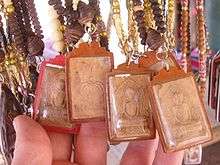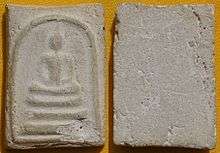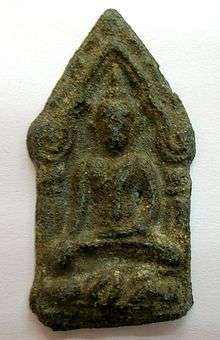Thai Buddha amulet

A Thai Buddha amulet (Thai: พระเครื่อง), often referred to academically as votive tablet, is a kind of Thai Buddhist blessed item. It is used for raising funds in order to help the temple producing the amulets. Worshippers can obtain an amulets or Thai Buddhist monk blessing by simply donating money or offering oil to the temple. After the donation, Thai Buddhist monk will give amulet as a gift to them. With the change of time, amulet no longer simply means as a "gift" , but a kind of tool to help enhance luck in different aspects, some people use amulets to improve marriage, wealth, health, love and people relationship.
It is also a tradition to place Thai amulets under stupa or other temple structure when it is built. When the structure collapses, many amulets are found. Some can be dated back over a century.[1][2]
Almost every Thai Buddhist has at least one Thai amulets. They have great respect for the Buddha. It is common to see young or elderly people wear amulets, or packaged by amulets around the neck in order to get closer to the Buddha.
.jpg)
_29.jpg)
Amulets are made using the Buddha image, image of famous monk, or even image of the monks who made the amulets themselves and let believers wear on for security and peace. Amulets have different kind of sizes, different shapes and different materials such as plaster, bone, wood, metal. It may include ash from incenses or old temple structure, hair from famous monk, to add protection power to the amulets.[3] After the amulets were made, the maker will then ask the monks who live in temples or monks from other temples join together and practice will, chant, pray and bless the amulets, this process may need at least one week more than three years.
When a new amulet freshly made, its plaster appearance may not be attractive or gorgeous. By adding packaging, a common amulet becomes a beautiful, stylish amulets and at the same time protect the amulet inside. The price of an amulets not only depends on its appearance, but also on its scarcity, maker (which monk or magician), year of made and the magic classes as well.
Famous market for amulets includes Tha Phrachan market next to Thammasat University.
Famous Thai Amulets
Benja Phakhi
The most famous of Thai amulets are the set of 5 rarest and highly sought after amulets Phra Somdej Wat Rakhang (Thai: พระสมเด็จวัดระฆัง), Phra Rod(Thai: พระรอด), Phra Nang Phaya (Thai: พระนางพญา), Phra Phong Suphan (Thai: พระผงสุพรรณ) and Phra Sum Kor (Thai: พระซุ้มกอ), together called Benja Phakhi (Thai: เบญจภาคี).[4] They are valued at over 10 million Baht.[5]
Phra Somdej

Phra Somdej (Thai: พระสมเด็จ) amulets are "King of amulets" said, also Known as "lucky amulets" is one of the famous amulet. Each amulet collectors must have one and it is the best and foremost choice to the new believer of Thai Amulet. Para Somdej own the most noblest status in Buddhism. The most famous of this kind is the Phra Somdej Wat Rakhang produced in around 1866 to 1871, by Somdej Toh of Wat Rakhang Khositaram (Thai: วัดระฆังโฆษิตาราม).[6] He is among the most respected monk in Thailand too.
Phra Somdej Chitralada is the amulets made by King Bhumibol himself and awarded during 1965 till 1970 to selected soldiers, policement, government officers and citizen.[7] Not exceeding 3000 of those are amulets made. Each amulet is accompanied with certificate stating name of recipient, date and amulet number. As of 2013, a Phra Somdej Chitralada worths at least 2 million Baht.
In general, most Phra Somdej amulets do not have eyes, nose and mouth. The Buddha image in Phra Somdej seated on the three-level throne representing heaven, people and earth. However, the Phra Somdej later appeared with five, seven, nine, ten level throne, as well as thirteen, but the concept of the throne is still the same. The meaning of Heaven, people and earth is to remind one must be humble, and everything was planned by the nature and God. Like other Thai Amulet, Phra Somdej is usually made of Temple dirt, pollen, monk's hair and the holy robe wore by the monk, etc.
The main function of Phra Somdej amulets ranges form protection from dangerous to enhance people relationship, from enhancing marriage relationship to enhancing health, from deliver us from demon to block disaster and from strengthen our career to adjusting the human aura field. Most importantly, it can help bring peace to different walks of life.
Phra Rod
Phra Rod refers to amulets discovered in early King Chulalongkorn era inside a partially collapsed stupa in Wat Mahawan (Thai: วัดมหาวัน) in Lamphun Province. It was named Phra Rod because the Buddha image in the amulet matched the an ancient Buddha image in the temple's Ubosot called Phra Rod Luang (Thai: พระรอดหลวง). Legends say that when the temple was part of Hariphunchai Kingdom, the amulets were crafted by Rishi to hand out to citizen during wars and the remaining of those were placed inside the temple's stupa.[4]
Phra Nang Phaya
Phra Nang Phaya amulet from Wat Nang Phaya temple in Phitsanulok Province is believed to be commissioned by Queen Wisutkasat in the Ayutthaya Kingdom. The amulet was discovered when workers dug up an area in the temple to prepare the stage for King Chulalongkorn's visit for the casting of a replica of famous Buddha image Phra Phuttha Chinnarat (Thai: พระพุทธชินราช) there. This amulet was also discovered in nearby temples such as Wat Ratchaburana (Thai: วัดราชบูรณะ).[4]
Phra Phong Suphan
Phra Phong Suphan is from Wat Phra Si Rattana Mahathat (Thai: วัดพระศรีรัตนมหาธาตุ) of Suphanburi Province. There were thieves to came to dig under the large stupa in the temple and stole amulets and tablets, some made from gold. So in 1913 Suphanburi governor ordered the formal dig up to uncover the buried amulets. Phra Phong Suphan was among the amulets found.[4]
Phra Sum Kor
Phra Sum Kar is from Kamphaeng Phet Province. When Somdej Toh came to visit relatives in 1849, he found Phra Sum Kor amulets at Wat Phraboromthat Nakhonchum (Thai: วัดพระบรมธาตุนครชุม) together with tablets explaining amulet making process. He later used the recipe to make his own Phra Somdej Wat Rakhang. This amulet is found throughout Thung Sethi (Thai: ทุ่งเศรษฐี) in Kamphangphet.[4]
Phra Khun Phaen

Phra Khun Phaen (Thai: พระขุนแผน) are amulets with the image of Khun Phaen of Khun Chang Khun Phaen folklore. According to the folklore, Khun Phaen was proficient in using magical power including amulets and other items in battle. Khun Phaen also used love formula to attract women. Thus, one of the main functions of Khun Phaen is to enhance the bonding of human relationship like: people relationship, marriage and heterosexual relationship. Also, it helps to enhance the career success like: academic success, fame and fortune, business success and faithful elegant.
Jatukham Rammathep
- Main article: Jatukham Rammathep
Jatukham Rammathep (Thai: จตุคามรามเทพ) is the name of two princes from Srivijaya Kingdom.[8] Nakhon Si Thammarat Province people consider Jatukham and Rammthep as guardian angels to the city. The Jatukham Rammathep amulet was first created by the late police Khun Phantharak Rajjadej (Thai: ขุนพันธรักษ์ราชเดช) in 1987 as part of Nakhon Si Thammarat's Lak Mueang establishment. The amulet is round-shaped, typically with the image of Hindu deities and around 5 cm in diameter. It became popular early 2000s, especially during the time of Khun Phantharak Rajjadej's funeral on 5 July 2006 till mid-2007. The amulet was believed to protect owner from danger and make owner rich. As many as 150 series of Jatukham Rammathep amulet production was planned for the year 2007 and the value of market for the amulet reach 20 billion Baht that year.[9] Late 2007 it appeared that the Jatukham Rammathep amulet bubble had burst, its popularity quickly faded with plenty of amulets left that could be obtained at very low price.[10]
Recommendation/Taboo
1. Do not wear Buddhist amulets under the waist. For most amulets, you have to wear it on neck or above the waist, this tradition is to show respect to the buddha. - Takrut (without monk/ buddhist image), can put inside your pants pocket.
2. It is recommended - do not put the Buddhist amulet in the bedroom, unless you don't process any sexual activity in the bedroom.
3. It is recommended to pray before and after you wear your amulets.
4. It is recommended to take off your amulets when you were bathing, this is to ensure the water would not damage the amulet.
5. It is not necessary to wear odd number (1,3,5) amulets on the neck. This is for balance purpose - but not necessary.
Prayer
Vandana
Namo tassa bhagavato arahato samma sambuddhassa This is a prayer to honor to the blessed One, the exalted One, the fully Enlightened One!! People usually say this prayer three times before and after wearing on the amulet. By saying this prayer, means showing absolute respect to the Buddha. This prayer can also be said before and carry out meditation.
See also
References
- ↑ "(in Thai) Amulets found under old 200-year-old stupa, people came to dig, and collector paid up to 3 Million for them.". 2013-04-21. Retrieved 2015-09-07.
- ↑ "(in Thai) Thousand of century-old amulets found, amulet collectors flocked the place.". 2013-04-21. Retrieved 2015-09-07.
- ↑ "Bangkok Buddhist amulet market". CNN Travel. 2009-10-21. Retrieved 2015-09-05.
- 1 2 3 4 5 "(in Thai) Follow the Trail of Benja Phakhi, The Origins of Most Sought After by Amulet Collectors". 2014-07-13. Retrieved 2015-09-05.
- ↑ "(in Thai) Phra Benja Phakhi". 2014-08-05. Retrieved 2015-09-05.
- ↑ "(in Thai) Phra Somdej Wat Rakhang, large die varient with names given for all 5 individual dies". 2015-02-07. Retrieved 2015-10-04.
- ↑ "(in Thai) Highly Desirable Phra Somdej Chitralada". 2013-05-04. Retrieved 2015-09-09.
- ↑ "Who is Jatukham Rammathep?". 2007-04-17. Retrieved 2015-09-08.
- ↑ "Thai amulet craze "unacceptable face of Buddhism"". Reuters. 2007-07-11. Retrieved 2015-09-05.
- ↑ "Losing its charm The bottom seems at last to have fallen out of the Jatukam market". 2007-08-26. Retrieved 2015-09-08.
The Arts of Faith: Explaining the Human side of Religions
- "Amulets in Bangkok". New York Times. 2005-12-18. Retrieved 2015-09-05.
External links
| Wikimedia Commons has media related to Amulets of Thailand. |